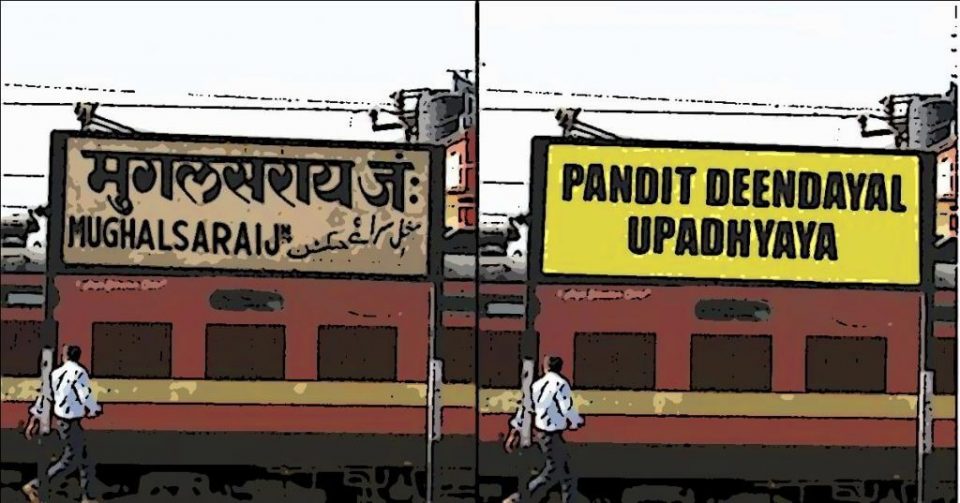A place’s name holds a cultural significance. But is the current BJP government trying to change the course of history?
Almost one year after receiving the letter of request, Uttar Pradesh Chief Minister, Yogi Adityanath on Monday released a notice stating that the name of Mughal Sarai Junction is officially renamed to Pt. Deen Dayal Upadhyay Junction. This decision has already fuelled the on-going controversy around the government’s name changing spree. Even when the bill was presented in the parliament, it was faced with a lot of opposition. The members of the opposition, namely Samajwadi Party’s Naresh Agarwal was protesting against the government’s approval of the decision. However, Yogi Adityanath asserted that this proposal was put forward so that the party can revive the legacy of the Bharatiya Jan Sangh leader, Deen Dayal Upadhaya.

Ever since it came to power in 2014, BJP government has changed the names of prominent places or landmarks. The government re-named the most prominent Aurangzeb Road in the Lutyen’s city after the late President, Dr APJ Abdul Kalam. The reasoning behind this move was that the party didn’t see it fit to ‘glorify’ a ruler that was seen as ‘anti-Hindu’ by the masses. Alongside these changes, an array of changes was proposed by RSS. To begin with, the Sangh put had forward the plea to change the name of Allahabad to Prayag, Ahmedabad to Karnavati, Hyderabad to Bhagyanagar, and Aurangabad to Sambhaji Nagar. The Sangh’s message was very clear- The old names of cities should be used and not the names given by the “invaders.”
However, it isn’t just the Mughal’s whose traces the government is trying to wipe from the map of India. Haryana government also re-named its corporate hub from Gurgaon to Gurugram.

This political edit of history isn’t just done by the current government. While BJP has been highly criticised for attempting to re-write the legacy of Mughals, it started with Mayawati imposing Dalit iconography on the people of Uttar Pradesh.
This spree isn’t just limited to changing the name of the place. It certainly could have another connotation.
Asserting ideological dominance
The history of a country is backed by the people and culture that we have assimilated over the years. Our present-day culture is an amalgamation of ideas, customs and social behaviours we’ve learnt from the people who lived and perhaps ruled before our time.
With attempts to change the names of iconic places in the country increasing, right before the election, one tends to wonder if the country is seeing a quest to have an ideological dominance by the ruling party. With the removal of existing, well-known names of landmarks, is the government trying to alter the building blocks on which the existence of India stands? One cannot deny the influence Mughals had on the history of the country; be it the cuisines, the architectural marvels or the atrocities our ancestors had to face. Is the current government trying to deny the people of its past?
Political Mementos?
Over the due course of time, BJP is putting its decisions to change the name of a place on a pedestal. Since the Lok Sabha elections are around the corner, it is becoming crucial for BJP to appease its core vote bank, the hard-line Hindutva preachers. The party is constantly seen diverting from its agenda of development in the country to go back to the core reason of winning the election in 2014.

The concept of changing re-naming place and landmarks with that of the Vedic times seem to hold a cultural belief in the mind of BJP leaders. BJP top guns see it as an attempt to keep the Hindu vote bank within its grip. The naming of Oshiwara station in Mumbai as Ram Mandir from the go was seen as a move to please the Hindu voters and as a way to assert the party’s personal ideology on the masses. This move was mocked by the opposition. Even its closest ally and Hindutva flagbearer mocked the party by saying “Ayodhya mein mandir toh bana nahi paye, idhar he sahi.”
While campaigning for elections, these acts could be used like the trophies BJP to show its voters and reassure them that they stood by what they had promised. while campaigning for elections in the last term- the spread and better treatment of Hindus.
Marking their territory
The previous government, in its desperate attempt to channelize Nehru-Gandhi contribution for the country, started naming every new project after them. It was seen as an attempt to leave an impact of the Nehru-Gandhi lineage in the collective consciousness.
BJP is trotting the same lines when it is broad lining its Hindu political leaders by naming and re-naming places after them. Prime Minister Narendra Modi has led this political project from the front. In his speeches, Modi was seen clubbing Mahatma Gandhi, Lohia and Upadhyay in a trio of Indian politically sound leaders of the last century.
Will this name changing strategy actually help Hinduism?
The constant endeavour to change the name of an iconic place looks like a frail attempt on BJP’s side to knock on the doors of its hardline Hindutva vote bank. However, the questions are will Hinduism be benefited from these? Will Hinduism spread by such acts of symbolism? Moreover, the name of a place holds a cultural significance and merely changing the name will not change the essence of a place from its history.
As Shakespeare says “what is in a name?” However, for political leaders, it seems like their stake to power is in these names.
As an independent media platform, we do not take advertisements from governments and corporate houses. It is you, our readers, who have supported us on our journey to do honest and unbiased journalism. Please contribute, so that we can continue to do the same in future.

